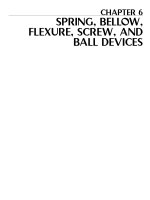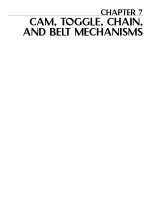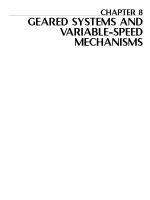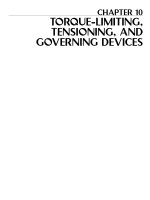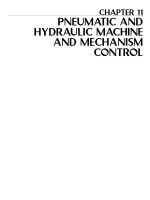Mechanisms and Mechanical Devices Sourcebook - Chapter 1
Bạn đang xem bản rút gọn của tài liệu. Xem và tải ngay bản đầy đủ của tài liệu tại đây (853.65 KB, 17 trang )
CHAPTER 2
ROBOT MECHANISMS
Sclater Chapter 2 5/3/01 10:09 AM Page 33
The programmability of the industrial robot using computer
software makes it both flexible in the way it works and versatile
in the range of tasks it can accomplish. The most generally
accepted definition of a
robot is a reprogrammable, multi-
function manipulator designed to move material, parts, tools, or
specialized devices through variable programmed motions to
perform a variety of tasks. Robots can be floor-standing, bench-
top, or mobile.
Robots are classified in ways that relate to the characteristics
of their control systems, manipulator or arm geometry, and
modes of operation. There is no common agreement on or stan-
dardizations of these designations in the literature or among
robot specialists around the world.
A basic robot classification relates to overall performance and
distinguishes between limited and unlimited sequence control.
Four classes are generally recognized: limited sequence and
three forms of unlimited sequence—point-to-point, continuous
path, and controlled path. These designations refer to the path
taken by the end effector, or tool, at the end of the robot arm as it
moves between operations.
Another classification related to control is
nonservoed versus
servoed. Nonservoed implies open-loop control, or no closed-
loop feedback, in the system. By contrast, servoed means that
some form of closed-loop feedback is used in the system, typi-
cally based on sensing velocity, position, or both. Limited
sequence also implies nonservoed control while unlimited
sequence can be achieved with point-to-point, continuous-path,
or controlled-path modes of operation.
Robots are powered by electric, hydraulic, or pneumatic
motors or actuators. Electric motor power is most popular for the
major axes of floor-standing industrial robots today. Hydraulic-
drive robots are generally assigned to heavy-duty lifting applica-
tions. Some electric and hydraulic robots are equipped with
pneumatic-controlled tools or end effectors.
The number of degrees of freedom is equal to the number of
axes of a robot, and is an important indicator of its capability.
Limited-sequence robots typically have only two or three
degrees of freedom, but point-to-point, continuous-path, and
controlled-path robots typically have five or six. Two or three of
those may be in the wrist or end effector.
Most heavy-duty industrial robots are floor-standing. Figure 1
shows a typical floor-standing robot system whose principal axes
are powered by responsive electric motors. Others in the same
size range are powered by hydraulic motors. The console con-
tains a digital computer that has been programmed with an oper-
ating system and applications software so that it can perform the
tasks assigned to it. Some robot systems also include training
pendants—handheld pushbutton panels connected by cable to
the console that permit direct control of the robot.
The operator or programmer can control the movements of
the robot arm or manipulator with pushbuttons or other data
input devices so that it is run manually through its complete task
34
INDUSTRIAL ROBOTS
Fig. 1 Components of a floor-standing, six-degree-of-freedom industrial robot. The principal axes are
driven by servo-controlled electric motors. The digital computer and remote-control pendant are located in
the computer control console.
Sclater Chapter 2 5/3/01 10:09 AM Page 34
sequence to program it. At this time adjustments can be made to
prevent any part of the robot from colliding with nearby objects.
There are also many different kinds of light-duty assembly or
pick-and-place robots that can be located on a bench. Some of
these are programmed with electromechanical relays, and others
are programmed by setting mechanical stops on pneumatic
motors.
Robot versus Telecheric
The true robot should be distinguished from the manually con-
trolled manipulator or
telecheric, which is remotely controlled by
human operators and not programmed to operate automatically
and unattended. These machines are mistakenly called robots
because some look like robots or are equipped with similar com-
ponents. Telecherics are usually controlled from a remote loca-
tion by signals sent over cable or radio link.
Typical examples of telecherics are manually controlled
manipulators used in laboratories for assembling products that
contain radioactive materials or for mixing or analyzing radioac-
tive materials. The operator is shielded from radiation or haz-
ardous fumes by protective walls, airlocks, special windows, or a
combination of these. Closed-circuit television permits the oper-
ator to view the workplace so that precise or sensitive work can
be performed. Telecherics are also fitted to deep-diving sub-
mersibles or extraterrestrial landing platforms for gathering spec-
imens in hostile or inaccessible environments.
Telecherics can be mobile machines equipped with tanklike
treads that can propel it over rough terrain and with an arm that
can move in three or more degrees of freedom. Depending on its
mission, this kind of vehicle can be equipped with handlike grip-
pers or other specialized tools for performing various tasks in
environments where hazardous materials have been spilled or
where fires are burning. Other missions might include bomb dis-
posal, firefighting, or gathering information on armed criminals
or persons trapped in confined spaces following earthquakes or
explosions. Again, a TV camera gives the operator information
for guidance.
Robot Advantages
The industrial robot can be programmed to perform a wider
range of tasks than dedicated automatic machines, even those
that can accept a wide selection of different tools. However, the
full benefits of a robot can be realized only if it is properly inte-
grated with the other machines human operators, and processes.
It must be evaluated in terms of cost-effectiveness of the per-
formance or arduous, repetitious, or dangerous tasks, particularly
in hostile environments. These might include high temperatures,
high humidity, the presence of noxious or toxic fumes, and prox-
imity to molten metals, welding arcs, flames, or high-voltage
sources.
The modern industrial robot is the product of developments
made in many different engineering and scientific disciplines,
with an emphasis on mechanical, electrical, and electronic tech-
nology as well as computer science. Other technical specialties
that have contributed to robot development include servomech-
anisms, hydraulics, and machine design. The latest and most
advanced industrial robots include dedicated digital computers.
The largest number of robots in the world are limited-
sequence machines, but the trend has been toward the electric-
motor powered, servo-controlled robots that typically are floor-
standing machines. Those robots have proved to be the most
cost-effective because they are the most versatile.
Trends in Robots
There is evidence that the worldwide demand for robots has yet
to reach the numbers predicted by industrial experts and vision-
aries some ten years ago. The early industrial robots were expen-
sive and temperamental, and they required a lot of maintenance.
Moreover, the software was frequently inadequate for the
assigned tasks, and many robots were ill-suited to the tasks
assigned them.
Many early industrial customers in the 1970s and 1980s
were disappointed because their expectations had been unreal-
istic; they had underestimated the costs involved in operator
training, the preparation of applications software, and the inte-
gration of the robots with other machines and processes in the
workplace.
By the late 1980s, the decline in orders for robots drove most
American companies producing them to go out of business, leav-
ing only a few small, generally unrecognized manufacturers.
Such industrial giants as General Motors, Cincinnati Milacron,
General Electric, International Business Machines, and
Westinghouse entered and left the field. However, the Japanese
electrical equipment manufacturer Fanuc Robotics North
America and the Swedish-Swiss corporation Asea Brown Boveri
(ABB) remain active in the U.S. robotics market today.
However, sales are now booming for less expensive robots
that are stronger, faster, and smarter than their predecessors.
Industrial robots are now spot-welding car bodies, installing
windshields, and doing spray painting on automobile assembly
lines. They also place and remove parts from annealing furnaces
and punch presses, and they assemble and test electrical and
mechanical products. Benchtop robots pick and place electronic
components on circuit boards in electronics plants, while mobile
robots on tracks store and retrieve merchandise in warehouses.
The dire predictions that robots would replace workers in
record numbers have never been realized. It turns out that the
most cost-effective robots are those that have replaced human
beings in dangerous, monotonous, or strenuous tasks that
humans do not want to do. These activities frequently take place
in spaces that are poorly ventilated, poorly lighted, or filled with
noxious or toxic fumes. They might also take place in areas with
high relative humidity or temperatures that are either excessively
hot or cold. Such places would include mines, foundries, chemi-
cal processing plants, or paint-spray facilities.
Management in factories where robots were purchased and
installed for the first time gave many reasons why they did this
despite the disappointments of the past ten years. The most fre-
quent reasons were the decreasing cost of powerful computers as
well as the simplification of both the controls and methods for
programming the computers. This has been due, in large meas-
ure, to the declining costs of more powerful microprocessors,
solid-state and disk memory, and applications software.
However, overall system costs have not declined, and there
have been no significant changes in the mechanical design of
industrial robots during the industrial robot’s ten-year “learning
curve” and maturation period.
The shakeout of American robot manufacturers has led to the
near domination of the world market for robots by the Japanese
manufacturers who have been in the market for most of the past
ten years. However, this has led to de facto standardization in
robot geometry and philosophy along the lines established by the
Japanese manufacturers. Nevertheless, robots are still available
in the same configurations that were available five to ten years
ago, and there have been few changes in the design of the end-
use tools that mount on the robot’s “hand” for the performance of
specific tasks (e.g., parts handling, welding, painting).
Robot Characteristics
Load-handling capability is one of the most important factors in
a robot purchasing decision. Some can now handle payloads of
as much as 200 pounds. However, most applications do not
require the handling of parts that are as heavy as 200 pounds.
High on the list of other requirements are “stiffness”—the ability
35
Sclater Chapter 2 5/3/01 10:09 AM Page 35
of the robot to perform the task without flexing or shifting; accu-
racy—the ability to perform repetitive tasks without deviating
from the programmed dimensional tolerances; and high rates of
acceleration and deceleration.
The size of the manipulator or arm influences accessibility to
the assigned floor space. Movement is a key consideration in
choosing a robot. The robot must be able to reach all the parts or
tools needed for its application. Thus the robot’s working range
or envelope is a critical factor in determining robot size.
Most versatile robots are capable of moving in at least five
degrees of freedom, which means they have five axes. Although
most tasks suitable for robots today can be performed by
robots with at least five axes, robots with six axes (or degrees
of freedom) are quite common. Rotary base movement and
both radial and vertical arm movement are universal. Rotary
wrist movement and wrist bend are also widely available. These
movements have been designated as roll and pitch by some robot
manufacturers. Wrist yaw is another available degree of freedom.
More degrees of freedom or axes can be added externally by
installing parts-handling equipment or mounting the robot on
tracks or rails so that it can move from place to place. To be most
effective, all axes should be servo-driven and controlled by the
robot’s computer system.
Principal Robot Categories
There are four principal geometries for robot manipulators:
(1) articulated, revolute, or jointed-arm (Figs. 2 and 3); (2) polar
coordinate (Fig. 4); (3) Cartesian (Fig. 5); and (4) cylindrical
(Fig. 6). However, there are many variations possible on these
basic designs, including vertically jointed (Fig. 7), horizontally
jointed, and gantry or overhead-configured.
The robot “wrist” is mounted on the end of the robot’s arm
and serves as a tool holder. It can also provide additional axes or
degrees of freedom, which is particularly desirable when the end
effector, such as welding electrodes or a paint spray gun, must be
maneuvered within confined spaces. Three common forms of
end effector are illustrated in Figs. 8, 9, and 10.
There are many different kind of end effectors, but among the
most common are hand-like grippers that can pick up, move, and
release objects. Some are general purpose, but others are specially
machined to fit around specific objects. Crude in comparison with
a human hand, the grippers must be able to pick up an object and
hold it securely without damaging or dropping it. Three of the
most common designs are illustrated in Figs. 11, 12, and 13.
36
Fig. 2 A low-shoulder, articulated, revolute, or jointed-geometry
robot has a base or waist, an upper arm extending from the shoulder
to the elbow, and a forearm extending from the elbow to the wrist.
This robot can rotate at the waist, and both upper and lower arms
can move independently through angles in the vertical plane. The
angle of rotation is θ (theta), the angle of elevation is β (beta), and
the angle of forearm movement is α (alpha).
Fig. 3 A high-shoulder articulated, revolute, or jointed-
geometry robot has a base or waist, an upper arm extending from
the shoulder to the elbow, and a forearm extending from the elbow to
the wrist. This robot can also rotate at the waist, and both upper and
lower arms can move independently through angles in the vertical
plane. As in Fig. 2, the angle of rotation is θ (theta), the angle of ele-
vation is β (beta), and the angle of forearm movement is α (alpha).
Fig. 4 A polar coordinate or gun-turret-geometry robot has a
main body or waist that rotates while the arm can move in elevation
like a gun barrel. The arm is also able to extend or reach. The angle
of rotation in this robot is θ (theta), the angle of elevation is β (beta),
and the reciprocal motion of the arm is γ (gamma).
Sclater Chapter 2 5/3/01 10:09 AM Page 36
37
Fig. 5 The Cartesian-coordinate-geometry robot has three linear
axes, X, Y, and Z. A moving arm mounted on a vertical post moves
along a linear track. The base or X axis is usually the longest; the
vertical axis is the Z axis; and the horizontal axis, mounted on the
vertical posts, is the Y axis. This geometry is effective for high-speed,
low-weight robots.
Fig. 8 A two-degree-of-freedom robot wrist can move a tool on
its mounting plate around both pitch and roll axes.
Fig. 9 This two-degree-of-freedom robot wrist can move a tool
on its mounting plate around the pitch and two independent roll axes.
Fig. 6 The cylindrical-coordinate-geometry robot can have the
same geometry as the Cartesian-coordinate robot (Fig. 5) except that
its forearm is free to rotate. Alternatively, it can have a rotating waist
like the polar-coordinate robot (Fig. 4) or the revolute-coordinate-
geometry robot (Figs. 2 and 3). The Z axis defines vertical movement
of the arm, and the Y axis defines traverse motion. Again, the angle
of rotation is defined by θ (theta).
Fig. 7 A vertically-jointed robot is similar to an articulated robot,
except that the mechanism is turned on its side, and the axes of rota-
tion are vertical. The mechanism is then mounted on a vertical post
or linear side, as shown. In another variation, the horizontally jointed
robot, the mechanism is turned so that the slide is horizontal.
Sclater Chapter 2 5/3/01 10:09 AM Page 37
38
Fig. 10 A three-degree-of-freedom robot wrist can move a tool
on its mounting plate around the pitch, roll, and yaw axes.
Fig. 13 A hydraulic or pneumatic piston opens and closes the
jaws of this robot gripper, permitting it to grasp and release objects.
Fig. 11 A reciprocating lever mechanism opens and closes the
jaws of this robot gripper, permitting it to grasp and release objects.
Fig. 12 A rack and pinion mechanism opens and closes the jaws
of this robot gripper, permitting it to grasp and release objects.
FANUC ROBOT SPECIFICATIONS
The data sheets for three robots from FANUC Robotics North
America, Inc., Rochester Hills, Michigan, have been reproduced
on the following pages to illustrate the range of capabilities of
industrial robots now in production. These specifications include
the manufacturer’s ratings for the key characteristics: motion
range and speed, wrist load moments and inertias, repeatability,
reach, payload, and weight.
S-900iH/i L/i W Robots
There are three robots in the S-900i family: S-900iH, S-900iL,
and S-900
iW. They are floor-standing, 6-axis, heavy-duty robots
with reaches of between 8 and 10 ft, (2.5 and 3.0 m) and maxi-
mum payloads of 441 to 880 lb (200 to 400 kg). S-900
i robots
can perform such tasks as materials handling and removal, load-
ing and unloading machines, heavy-duty spot welding, and par-
ticipation in casting operations.
These high-speed robots are controlled by FANUC R-J3 con-
trollers, which provide point-to-point positioning and smooth
controlled motion. S-900
i robots have high-inertia wrists with
large allowable moments that make them suitable for heavy-duty
work in harsh environments. Their slim J3 outer arms and wrist
profiles permit these robots to work in restricted space, and their
small footprints and small i-size controllers conserve factory
floor space. Many attachment points are provided on their wrists
for process-specific tools, and axes J5 and J6 have precision gear
drives. All process and application cables are routed through the
arm, and there are brakes on all axes.
S-900
i robots support standard I/O networks and have stan-
dard Ethernet ports. Process-specific software packages are
available for various applications. Options include B-size con-
troller cabinets, additional protection for harsh environments, a
precision baseplate for quick robot exchanges, and integrated
auxiliary axes packages.
Sclater Chapter 2 5/3/01 10:09 AM Page 38
